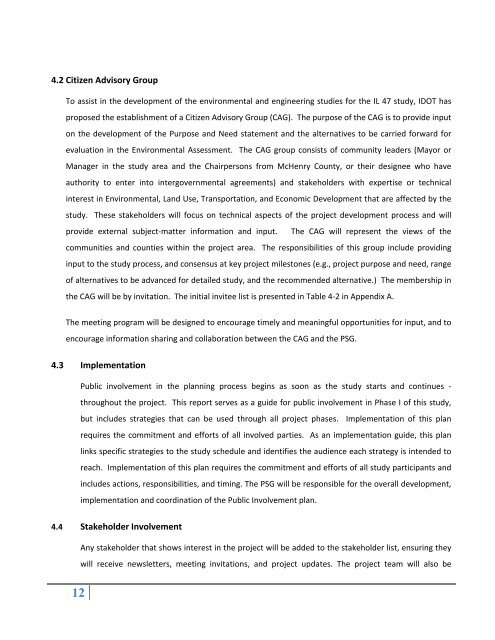SIP - Illinois Department of Transportation
SIP - Illinois Department of Transportation
SIP - Illinois Department of Transportation
You also want an ePaper? Increase the reach of your titles
YUMPU automatically turns print PDFs into web optimized ePapers that Google loves.
4.2 Citizen Advisory Group<br />
To assist in the development <strong>of</strong> the environmental and engineering studies for the IL 47 study, IDOT has<br />
proposed the establishment <strong>of</strong> a Citizen Advisory Group (CAG). The purpose <strong>of</strong> the CAG is to provide input<br />
on the development <strong>of</strong> the Purpose and Need statement and the alternatives to be carried forward for<br />
evaluation in the Environmental Assessment. The CAG group consists <strong>of</strong> community leaders (Mayor or<br />
Manager in the study area and the Chairpersons from McHenry County, or their designee who have<br />
authority to enter into intergovernmental agreements) and stakeholders with expertise or technical<br />
interest in Environmental, Land Use, <strong>Transportation</strong>, and Economic Development that are affected by the<br />
study. These stakeholders will focus on technical aspects <strong>of</strong> the project development process and will<br />
provide external subject‐matter information and input. The CAG will represent the views <strong>of</strong> the<br />
communities and counties within the project area. The responsibilities <strong>of</strong> this group include providing<br />
input to the study process, and consensus at key project milestones (e.g., project purpose and need, range<br />
<strong>of</strong> alternatives to be advanced for detailed study, and the recommended alternative.) The membership in<br />
the CAG will be by invitation. The initial invitee list is presented in Table 4‐2 in Appendix A.<br />
The meeting program will be designed to encourage timely and meaningful opportunities for input, and to<br />
encourage information sharing and collaboration between the CAG and the PSG.<br />
4.3 Implementation<br />
12<br />
Public involvement in the planning process begins as soon as the study starts and continues ‐<br />
throughout the project. This report serves as a guide for public involvement in Phase I <strong>of</strong> this study,<br />
but includes strategies that can be used through all project phases. Implementation <strong>of</strong> this plan<br />
requires the commitment and efforts <strong>of</strong> all involved parties. As an implementation guide, this plan<br />
links specific strategies to the study schedule and identifies the audience each strategy is intended to<br />
reach. Implementation <strong>of</strong> this plan requires the commitment and efforts <strong>of</strong> all study participants and<br />
includes actions, responsibilities, and timing. The PSG will be responsible for the overall development,<br />
implementation and coordination <strong>of</strong> the Public Involvement plan.<br />
4.4 Stakeholder Involvement<br />
Any stakeholder that shows interest in the project will be added to the stakeholder list, ensuring they<br />
will receive newsletters, meeting invitations, and project updates. The project team will also be


